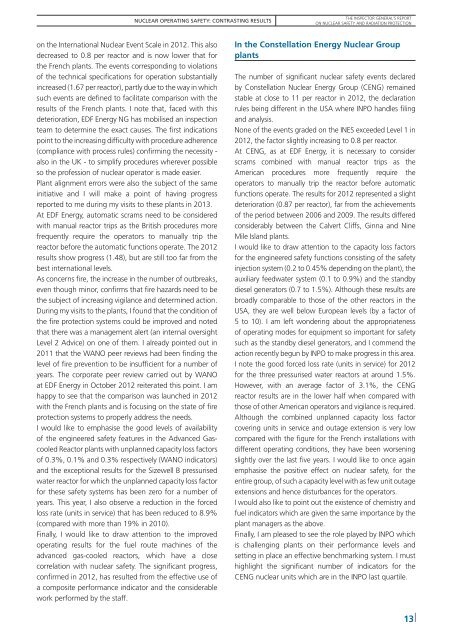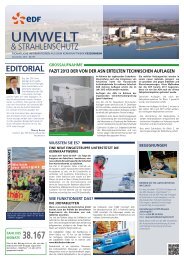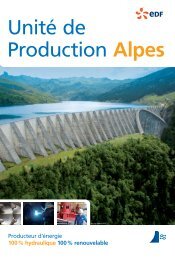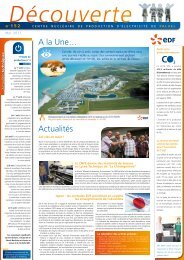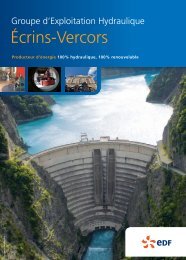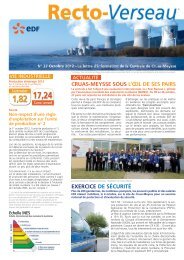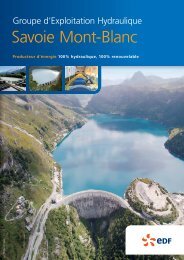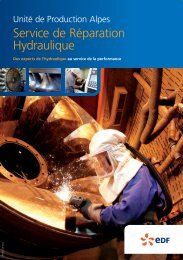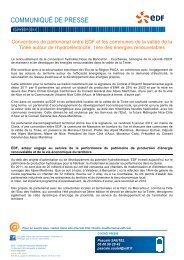on Nuclear Safety and Radiation Protection - Energie EDF
on Nuclear Safety and Radiation Protection - Energie EDF
on Nuclear Safety and Radiation Protection - Energie EDF
Create successful ePaper yourself
Turn your PDF publications into a flip-book with our unique Google optimized e-Paper software.
NUCLEAR OPERATING SAFETY: CONTRASTING RESULTS<br />
<strong>on</strong> the Internati<strong>on</strong>al <strong>Nuclear</strong> Event Scale in 2012. This also<br />
decreased to 0.8 per reactor <strong>and</strong> is now lower that for<br />
the French plants. The events corresp<strong>on</strong>ding to violati<strong>on</strong>s<br />
of the technical specificati<strong>on</strong>s for operati<strong>on</strong> substantially<br />
increased (1.67 per reactor), partly due to the way in which<br />
such events are defined to facilitate comparis<strong>on</strong> with the<br />
results of the French plants. I note that, faced with this<br />
deteriorati<strong>on</strong>, <strong>EDF</strong> Energy NG has mobilised an inspecti<strong>on</strong><br />
team to determine the exact causes. The first indicati<strong>on</strong>s<br />
point to the increasing difficulty with procedure adherence<br />
(compliance with process rules) c<strong>on</strong>firming the necessity -<br />
also in the UK - to simplify procedures wherever possible<br />
so the professi<strong>on</strong> of nuclear operator is made easier.<br />
Plant alignment errors were also the subject of the same<br />
initiative <strong>and</strong> I will make a point of having progress<br />
reported to me during my visits to these plants in 2013.<br />
At <strong>EDF</strong> Energy, automatic scrams need to be c<strong>on</strong>sidered<br />
with manual reactor trips as the British procedures more<br />
frequently require the operators to manually trip the<br />
reactor before the automatic functi<strong>on</strong>s operate. The 2012<br />
results show progress (1.48), but are still too far from the<br />
best internati<strong>on</strong>al levels.<br />
As c<strong>on</strong>cerns fire, the increase in the number of outbreaks,<br />
even though minor, c<strong>on</strong>firms that fire hazards need to be<br />
the subject of increasing vigilance <strong>and</strong> determined acti<strong>on</strong>.<br />
During my visits to the plants, I found that the c<strong>on</strong>diti<strong>on</strong> of<br />
the fire protecti<strong>on</strong> systems could be improved <strong>and</strong> noted<br />
that there was a management alert (an internal oversight<br />
Level 2 Advice) <strong>on</strong> <strong>on</strong>e of them. I already pointed out in<br />
2011 that the WANO peer reviews had been finding the<br />
level of fire preventi<strong>on</strong> to be insufficient for a number of<br />
years. The corporate peer review carried out by WANO<br />
at <strong>EDF</strong> Energy in October 2012 reiterated this point. I am<br />
happy to see that the comparis<strong>on</strong> was launched in 2012<br />
with the French plants <strong>and</strong> is focusing <strong>on</strong> the state of fire<br />
protecti<strong>on</strong> systems to properly address the needs.<br />
I would like to emphasise the good levels of availability<br />
of the engineered safety features in the Advanced Gascooled<br />
Reactor plants with unplanned capacity loss factors<br />
of 0.3%, 0.1% <strong>and</strong> 0.3% respectively (WANO indicators)<br />
<strong>and</strong> the excepti<strong>on</strong>al results for the Sizewell B pressurised<br />
water reactor for which the unplanned capacity loss factor<br />
for these safety systems has been zero for a number of<br />
years. This year, I also observe a reducti<strong>on</strong> in the forced<br />
loss rate (units in service) that has been reduced to 8.9%<br />
(compared with more than 19% in 2010).<br />
Finally, I would like to draw attenti<strong>on</strong> to the improved<br />
operating results for the fuel route machines of the<br />
advanced gas-cooled reactors, which have a close<br />
correlati<strong>on</strong> with nuclear safety. The significant progress,<br />
c<strong>on</strong>firmed in 2012, has resulted from the effective use of<br />
a composite performance indicator <strong>and</strong> the c<strong>on</strong>siderable<br />
work performed by the staff.<br />
THE INSPECTOR GENERAL’S REPORT<br />
ON NUCLEAR SAFETY AND RADIATION PROTECTION<br />
In the C<strong>on</strong>stellati<strong>on</strong> Energy <strong>Nuclear</strong> Group<br />
plants<br />
The number of significant nuclear safety events declared<br />
by C<strong>on</strong>stellati<strong>on</strong> <strong>Nuclear</strong> Energy Group (CENG) remained<br />
stable at close to 11 per reactor in 2012, the declarati<strong>on</strong><br />
rules being different in the USA where INPO h<strong>and</strong>les filing<br />
<strong>and</strong> analysis.<br />
N<strong>on</strong>e of the events graded <strong>on</strong> the INES exceeded Level 1 in<br />
2012, the factor slightly increasing to 0.8 per reactor.<br />
At CENG, as at <strong>EDF</strong> Energy, it is necessary to c<strong>on</strong>sider<br />
scrams combined with manual reactor trips as the<br />
American procedures more frequently require the<br />
operators to manually trip the reactor before automatic<br />
functi<strong>on</strong>s operate. The results for 2012 represented a slight<br />
deteriorati<strong>on</strong> (0.87 per reactor), far from the achievements<br />
of the period between 2006 <strong>and</strong> 2009. The results differed<br />
c<strong>on</strong>siderably between the Calvert Cliffs, Ginna <strong>and</strong> Nine<br />
Mile Isl<strong>and</strong> plants.<br />
I would like to draw attenti<strong>on</strong> to the capacity loss factors<br />
for the engineered safety functi<strong>on</strong>s c<strong>on</strong>sisting of the safety<br />
injecti<strong>on</strong> system (0.2 to 0.45% depending <strong>on</strong> the plant), the<br />
auxiliary feedwater system (0.1 to 0.9%) <strong>and</strong> the st<strong>and</strong>by<br />
diesel generators (0.7 to 1.5%). Although these results are<br />
broadly comparable to those of the other reactors in the<br />
USA, they are well below European levels (by a factor of<br />
5 to 10). I am left w<strong>on</strong>dering about the appropriateness<br />
of operating modes for equipment so important for safety<br />
such as the st<strong>and</strong>by diesel generators, <strong>and</strong> I commend the<br />
acti<strong>on</strong> recently begun by INPO to make progress in this area.<br />
I note the good forced loss rate (units in service) for 2012<br />
for the three pressurised water reactors at around 1.5%.<br />
However, with an average factor of 3.1%, the CENG<br />
reactor results are in the lower half when compared with<br />
those of other American operators <strong>and</strong> vigilance is required.<br />
Although the combined unplanned capacity loss factor<br />
covering units in service <strong>and</strong> outage extensi<strong>on</strong> is very low<br />
compared with the figure for the French installati<strong>on</strong>s with<br />
different operating c<strong>on</strong>diti<strong>on</strong>s, they have been worsening<br />
slightly over the last five years. I would like to <strong>on</strong>ce again<br />
emphasise the positive effect <strong>on</strong> nuclear safety, for the<br />
entire group, of such a capacity level with as few unit outage<br />
extensi<strong>on</strong>s <strong>and</strong> hence disturbances for the operators.<br />
I would also like to point out the existence of chemistry <strong>and</strong><br />
fuel indicators which are given the same importance by the<br />
plant managers as the above.<br />
Finally, I am pleased to see the role played by INPO which<br />
is challenging plants <strong>on</strong> their performance levels <strong>and</strong><br />
setting in place an effective benchmarking system. I must<br />
highlight the significant number of indicators for the<br />
CENG nuclear units which are in the INPO last quartile.<br />
13


